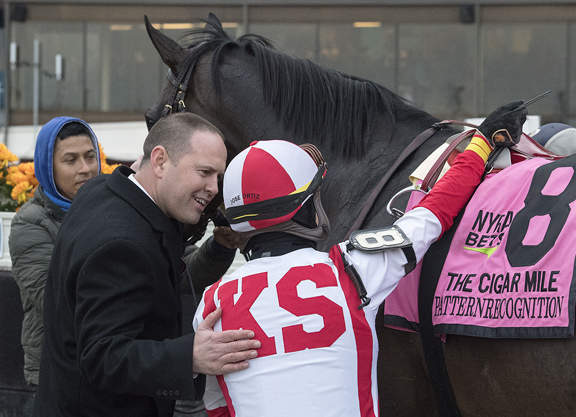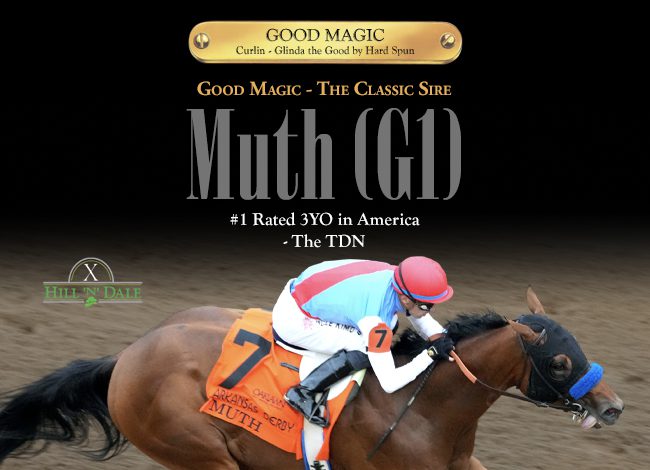By T. D. Thornton
Grade I racing on the East Coast has now settled into hibernation mode for the rest of the year, and after this coming Saturday's pair of Grade I events for juveniles at Los Alamitos, the entire continent won't see a Grade I contest until opening day at Santa Anita Dec. 26.
But the quartet of graded stakes action at Aqueduct Dec. 1, plus the GI Hollywood Derby at Del Mar, injected a touch of late-season intrigue that will whet the appetite for how the pecking order might shape up in several divisions as the calendar flips to 2019.
The catch is that you have to look past some quirky clockings in the New York races to get a clearer picture of the true efforts of the Aqueduct winners Saturday.
After handicappers nationwide spent the latter half of the weekend puzzling over some befuddling internal splits and final times, Daily Racing Form's Dave Grening broke news Sunday evening that a timing beam accidentally blocked by an auxiliary starting gate at Aqueduct resulted in three one-turn mile races on Saturday–including the GIII Go For Wand H.–being hand-timed from when the gate doors opened and not from the timing pole.
The allegedly distorted timings mark the second time in four months that a New York Racing Association track has had a significant gate-related gaffe. On Aug. 8, an incorrect pre-race gate placement at Saratoga caused a turf race to be run at 1 1/8 miles instead of the as-carded 1 1/16 miles, an embarrassment made worse by the failure of multiple track officials to recognize the mistake before the race went off.
As of press time for this column Sunday night, the official Equibase charts for Aqueduct races Saturday listed the first three one-turn mile races as having run-up distances of 0 feet, while the Cigar Mile's was listed as 54 feet.
According to the Form, Saturday's problem was rectified prior to Patternrecognition (Adios Charlie)'s wire job in the GI Cigar Mile H., which might be recalled months from now as the big coming-out party for the oft-sidelined 5-year-old. Despite a series of training setbacks since winning on debut in April of 2017, Patternrecognition has now racked up a 5-5-0 record from 11 lifetime starts.
Patternrecognition was always the controlling factor through demanding splits (:22.88, :45.68, 1:09.68) before staying on resolutely when ganged up on at the head of the lane. Saturday's winning time of 1:34.98 marked his second consecutive graded win after stepping up out of the allowance/optional claiming ranks.
Trainer Chad Brown said Sunday that the GI Pegasus World Cup at Gulfstream Park Jan. 26 is now under consideration for the Cigar Mile victor.
Patternrecognition's quick turn of early foot over a Florida racing surface that is generally perceived as kind to frontrunners could make him an enticing proposition in the nine-furlong Pegasus.
But pragmatists will note that, despite earning triple-digit Beyer Speed Figures in five of his last six races, Patternrecognition remains unraced around two turns, as his three career starts at a mile and one at 1 1/16 miles have all come over one-turn track configurations at Belmont Park and Aqueduct.
It's also worth noting that Patternrecognition's last two wins in the Cigar Mile and GII Kelso H. came in races where the heavy favorite failed to mount a serious bid: Battle of Midway (Smart Strike) was off the board at even money in the Kelso, and Mendelssohn (Scat Daddy) was retired to stud Sunday after his non-threatening fourth at 1.7-1 in the Cigar Mile.
The need to look beyond Saturday's wacky Aqueduct clockings applies most pertinently to Marley's Freedom (Blame), who rebounded back from 9-10 beaten favoritism in the GI Breeders' Cup Filly & Mare Sprint a month ago to nail a hard-fought, odds-on neck victory in the Go For Wand.
Considering that an uncharacteristically slow start is what compromised her chances in the Breeders' Cup (fourth, beaten only half a length), jockey Mike Smith wasted no time in asserting an intimidating stalking spot outside of a longshot pacemaker, ratcheting up the pressure from a posted opening quarter of :25.27 to a much more realistic-seeming second split of :23.29.
Marley's Freedom advanced in hand to commandeer the lead 2 1/2 furlongs out, then appeared to relish the pressure of a prolonged stretch drive with Come Dancing (Malibu Moon), who earned style points for her own resolute, runner-up effort. The top two hit the wire 6 3/4 lengths clear of the remainder of the overmatched field, stopping the timer in 1:38.35 for the one-turn mile.
Trainer Bob Baffert said Sunday that the California-based Marley's Freedom could be aimed for longer races in 2019, with an eventual target of nine furlongs to see if that distance might be a sweet spot.
But if a blocked timing beam accounted for aberrational clockings in the one-turn mile races, what explains the wide final time disparities in a pair of nine-furlong stakes run about two hours apart on a dry track labeled “fast”? According to the Equibase charts, the GII Demoiselle S. had a run-up distance of 104 feet, while the GII Remsen S. at the same distance is charted as having a 95-foot run-up.
Positive Spirit (Pioneerof the Nile), the juvenile half-sister to 2017 GI Kentucky Derby winner Always Dreaming (Bodemeister), stalked in third despite getting hung out four wide on both turns of the Demoiselle. The robust-framed filly was roused energetically off the final turn but was wrapped up late after polishing off her all-out rivals 10 1/2 lengths clear of the pack.
Her final time of 1:56.01 represents the slowest clocking of the Demoiselle since the race stretched out to nine furlongs in 1975, and no other edition of the race has ever produced a time above 1:54.60. Is this an aberration related to a shifting track surface? Regardless of the reason for the suspiciously slow final time, it would be wise to give credit to Positive Spirit more for how she ran her winning race rather than “how fast.”
By contrast, the winning effort by undefeated 'TDN Rising Star' Maximus Mischief (Into Mischief) in the Remsen four races later yielded a more believable clocking of 1:51.34.
But even though you could make the argument that the Aqueduct main track seemed to speed up as the Saturday program went on, “Max” still had to force the fray through two relatively uninspiring opening quarters of :25.12 and :25.55 before seizing control by cracking the pesky longshot Tax (Arch) and having enough late energy left in the tank to fend off 1.15-1 favorite Network Effect (Mark Valeski).
Again, don't put too much emphasis on the internal splits of the Remsen. Instead, the focus should be on how relaxed Max was when racing among rivals through the clubhouse bend in his two-turn debut and how he responded willingly when set down for the drive in the lane.
Maximus Mischief has returned to his home stable at Parx, but plans are in the works for the colt to winter in Florida for a planned attack on the Gulfstream Park sophomore prep path to the Kentucky Derby.
The biggest against-the-grain challenge for Maximus Mischief moving forward might have to more to do with bucking history than anything else: In the last 55 years, only three horses–Thunder Gulch, Go For Gin and Pleasant Colony–have successfully parlayed the Remsen into a blanket of roses on the first Saturday in May at Churchill Downs.
On the left coast, New York-based shipper Raging Bull (Fr) (Dark Angel {Ire}) annexed the GI Hollywood Derby in authoritative, off-the-pace fashion on closing weekend at Del Mar.
“I thought I was on the best horse, so I rode him that way,” said winning jockey Joel Rosario. “With him, he has a powerful quarter-mile kick at the end. Terrific acceleration. So I just needed to keep him outside; keep him in the clear where I could ride him at the finish. It worked out just the way I'd hoped.”
Not a subscriber? Click here to sign up for the daily PDF or alerts.






